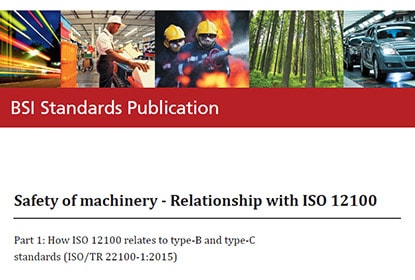Safety of machinery – Relationship with ISO 12100. Part 1: How ISO 12100 relates to type-B and type-C standards
Steve Allen, a Member of BSI’s MCE/3 committee and National Sales Manager for Procter Machine Safety, reviews this new Published Document from BSI.

PD CEN ISO/TR 22100-1:2017 explains how machinery safety standard ISO 12100 relates to type-B and type-C standards
BSI published PD CEN ISO/TR 22100-1:2017 (Safety of machinery – Relationship with ISO 12100 – Part 1: How ISO 12100 relates to type-B and type-C standards) in November 2017. This Published Document is the UK implementation of the European Technical Report CEN ISO/TR 22100-1:2017 and is identical to the International Technical Report ISO/TR 22100-1:2015. Note that PD CEN ISO/TR 22100-1:2017 supersedes PD ISO/TR 22100-1:2015, which has been withdrawn, but the two Published Documents appear to be identical other than the ‘CEN’ designation in the title, the addition of Annex ZA (Relation of this document to the Machinery Directive 2006/42/EC), and some notes that have not been carried over to this edition. Being a ‘published document’, PD CEN ISO/TR 22100-1:2017 does not carry the same weight as a British Standard.
A point to highlight from Annex ZA is that in PD CEN ISO/TR 22100-1:2017 the term ‘tolerable risk’ should be read as ‘residual risk’ as defined in ISO 12100-1 to be compliant with EU legislation. Although the two terms have different definitions, it is generally accepted that the residual risk is equal to or lower than the tolerable risk.
Most people reading this review will probably already understand the differences between type-A, type-B and type-C machinery safety standards but, for those who are not familiar with these designations, they can be summarised as follows:
- Type-A standards present basic concepts and principles for design that are applicable to all machinery;
- Type-B standards are generic standards, each dealing with one safety aspect or type of safeguard that can be applied to many different types of machinery; and
- Type-C standards are machine-specific, with detailed safety requirements.
Fuller descriptions of the three types are provided in Clause 4, General structure of the system of machinery safety standards and Clause 5, System of type-A, type-B and type-C standards. Sub-clause 5.2 also explains the difference between type-B1 and type-B2 standards.
Currently, there is only one type-A standard, ISO 12100:2010 (Safety of machinery – General principles for design – Risk assessment and risk reduction).
The main thrust of PD CEN ISO/TR 22100-1:2017 is contained in Clause 5 (mentioned above) and Clause 6, Practical application of ISO 12100, type-B and type-C standards in order to design a machine to achieve a level of tolerable risk by adequate risk reduction. Clause 6 includes a flow diagram showing recommended steps for using ISO 12100 and type-B and type-C standards. In particular, this helps readers to navigate the process when a type-C standard covers all or some of the hazards present on the machine.
If the machine in question is covered entirely by a type-C standard, the flow diagram can be seen to imply that the machine designer/manufacturer simply has to apply the standard and complete the necessary documentation. However, sub-clause 6.2.1 states that ‘the application of type-C standards does not dispense the machinery manufacturer from the obligation to carry out a risk assessment according to ISO 12100’.
One of the issues relating to the use of type-B and type-C standards is the question of how to identify which standards are applicable. Unfortunately PD CEN ISO/TR 22100-1:2017 only states ‘Machine designers and manufacturers should search for an appropriate type-C standard’ with no guidance provided on how or where to search. As an aside, the list of Harmonised Standards published on the European Commission website is probably the best place to start, and using a text search on the web page can be helpful provided your choice of search terms matches those used in the standards’ titles. While the proliferation of type-C standards is very useful for designers and manufacturers of machines covered by those standards, the sheer volume makes reading the list from top to bottom somewhat tedious.
When it comes to type-B standards, however, PD CEN ISO/TR 22100-1:2017 is more helpful. In Clause 7 (Navigating appropriate type-B machinery safety standards) there is an overview of the type-B standards, grouped into hazard categories, aspects and technologies; for example, there is a section for ‘noise’, another for ‘safety devices’, one for ‘dimensions and distances’, etc.
For those who understand the difference between type-A, type-B and type-C standards, and which standards to use when designing and manufacturing machines, PD CEN ISO/TR 22100-1:2017 may not add much to their knowledge. As a Published Document (in BSI terminology) and a Technical Report (in ISO terminology), purchasing a copy is probably less important than it is for applicable type-A, B and C Harmonised Standards.
For more information about machinery safety standards, visit the relevant page on the Procter Machine Safety website at www.machinesafety.co.uk/compliance/british-standards or download a copy of ‘‘On Your Guard’ (a designer’s guide to machinery guarding standards).
>> Next: Updated Guide to Machinery Guarding Standards
>> All Procter Machine Safety News
